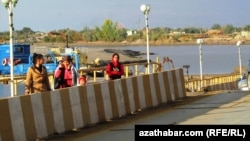![A spokesman for Faryab Governor Said Anwar Sadat (above) says around 6,000 armed militants are present in Faryab. “More than half of them are helping Afghan security forces [against the Taliban]," he says, "but the other half of them are those who prey on ordinary people.”](https://gdb.rferl.org/DA81BD75-3BFD-4594-90F4-9574CAD3A601_w250_r1_s.jpg)
Qishloq Ovozi has paid a good deal of attention to what is happening south of Central Asia, in Afghanistan. But most of these reports deal with unrest in the border area and the security problems militants in northern Afghanistan could pose to Central Asian countries.
Mustafa Sarwar, a correspondent for RFE/RL’s Radio Free Afghanistan, known locally as Azadi, came to me with a story about life and problems in Faryab, one of the Afghan provinces bordering Turkmenistan. RFE/RL’s Gandhara website visited this topic a couple of years back. What the Gandhara report described is still true but the scope is larger.
And remember, Central Asia is a big loser if the situation in northern Afghanistan falls into chaos, and this story of Faryab is likely similar to stories in most of the eight Afghan provinces bordering Central Asia.
"Around 6,000 armed militants are present in Faryab,” said Mohamad Jawid Bidar, a spokesman for Said Anwar Sadat, the Faryab governor. “More than half of them are helping Afghan security forces during operations [against the Taliban], but the other half of them are those who prey on ordinary people.”
These are Arbaky forces and Popular Uprising Forces or Kheizish-e Mardomi (as they are termed by the Interior Ministry) -- paramilitary groups that have some support from individuals in the Afghan government.
As Bidar noted, “In a province that has more than 1,300 villages with some 8,000 members of the security forces, it's very hard to establish posts in every village.” Which is why authorities have allowed these paramilitary forces to operate. Though Bidar admitted, “We do not have enough control on these [armed gangs].”
Mohammad Reza Rezayee, the head of public relations for 209 Shaheen Corps in Faryab, echoed Bidar’s comments, saying, “Some of them have played a positive role…but a number of them have caused concern for the locals, as well as for Afghan [government] forces.”
Rezayee claimed that “the provincial police command center provides them with ammunition to fight against the Taliban…but they sell some of the ammunition to the Taliban, which then is used against themselves and Afghan forces in the province.”
“Sometimes," he added, "they use the weapons against each other.”
Clearly, it is a confusing and terrifying situation for villagers, who have no way of knowing who these armed groups are -- pro-government paramilitaries or bandits connected to the government through vague promises.
Ahmad Jawid Kaiwan is the head of the Faryab Civil Society Network. He told Azadi, “Nowadays, people are more concerned about the popular uprising forces (the paramilitaries) than the Taliban because some of these [paramilitary] forces have ignited factional and ethnic fighting.”
Human Rights Watch recently released a report about abuses committed by some of these paramilitary groups, saying at one point that the use of these groups “has undermined security in northern Afghanistan.”
Kaiwan also conceded some of these paramilitary groups have “proven effective, but [they have] also created problems in many instances.”
Extortion is the biggest problem -- a fact mentioned by Bidar, Rezayee, and Kaiwan.
Said Hafizullah Fitrat is the head of the Faryab Human Rights Commission. He explained some of these Arbaky groups “are engaged in stealing. Sometime they commit sexual violence on people’s families. They want every household to pay them from 1,000 to 3,000 afghanis ($15 to $45) each month. They want people to give them food,” Fitrat said. “They even forcibly take people to their posts for hard work, such as bringing water from wells or digging…”
Some of these groups are protected by local law-enforcement officials; other groups have grown so strong that police are afraid and unable to act against them.
Abdul Karim is a villager in the Pashtun Kot district. He said the government should move against these groups.
“They are strongmen and they kill and extort people,” Karim said, “From our family, they have killed four of my brothers and I was shot.”
These paramilitary groups are a propaganda bonanza for the Taliban or other groups such as the so-called Islamic State militant group that are trying to get their own footholds in Afghanistan.
Rezayee of the 209 Shaheen Corps said the some of the groups “have created distance between the people and the government.”
We’ve heard during the Majlis podcast from analysts in Afghanistan who say that some Arbaky groups are so lawless that they are pushing villagers into the arms of the Taliban, who generally treat the population better than the paramilitaries do.
But with fighting now going on across northern Afghanistan, and government forces there stretched thin, these paramilitary groups are necessary to counter the growing number of Taliban fighters and foreign militants in the region.
In between these groups, as they have been for decades, are the villagers, who must endure the arrival of one armed group after another and wait and hope that one day, one of these groups might come to help them rather than steal from and abuse them.






